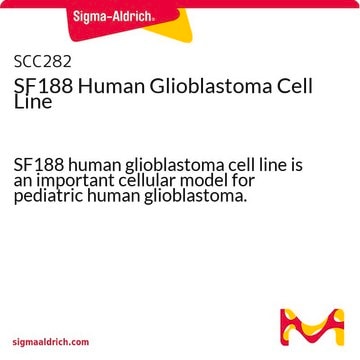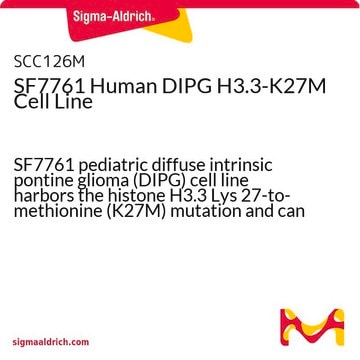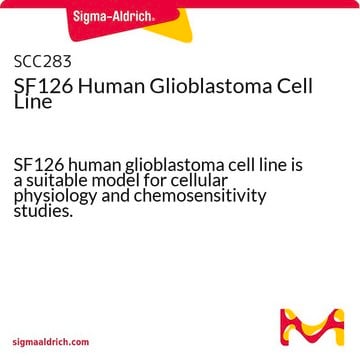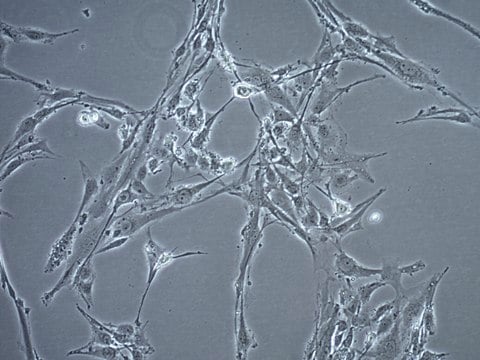SCC127M
SF8628 Human DIPG H3.3-K27M Cell Line
Human
Sinónimos:
SF-8628 cells
About This Item
Productos recomendados
product name
SF8628 Human DIPG H3.3-K27M Cell Line, SF8628 pediatric diffuse intrinsic pontine glioma (DIPG) cell line harbors the histone H3.3 Lys 27-to-methionine (K27M) mutation and can support research and drug development efforts targeting DIPG.
biological source
human
Quality Level
technique(s)
cell culture | mammalian: suitable
General description
A somatic mutation of histone H3.3 resulting in a lysine 27 to methionine substitution (H3.3K27M) occurs in 60% of DIPG (2). In H3.3K27M DIPG patient samples, levels of H3K27 dimethylation (H3K27me2) and trimethylation (H3K27me3) are reduced globally. These epigenetic changes are thought to be important factors driving DIPG oncogenesis (2,3,4). Expression of H3.3K27M was also recently shown to be associated with increased levels of H3K27 acetylation (H3K27ac) and recruitment of bromodomain proteins at sites of active transcription (5). Treatment of H3.3K27M DIPG cells with a bromodomain and extra-terminal domain (BET) inhibitor was found to inhibit proliferation and induced differentiation. BET inhibitors are thus a promising therapeutic approach for the treatment of DIPG.
1. Schroeder KM et al. (2014) Pediatr. Res. 75(1-2): 205–209.
2. Lewis PW et al. (2013) Science 340(6134): 857–861.
3. Chan K-M et al. (2013) Genes & Development 27: 985-990.
4. Hashizume R et al. (2014) Nat Med. 20(12):1394-6.
5. Piunti A et al. (2017) Nat. Med. 23(4): 493-500.
6. Mueller S et al. (2014) Neuro Oncol. 16(3): 352-360.
Cell Line Description
Application
Cancer
Oncology
Quality
• Cells are tested negative for Epstein-Barr virus, HPV-16, HPV-18, Hepatitis A, C, Herpesvirus type 6, 7, 8 and HIV-1 & 2 viruses by PCR
• Cells are negative for mycoplasma contamination.
• Each lot of cells is genotyped by STR analysis to verify the unique identity of the cell line
Storage and Stability
Disclaimer
Storage Class
10 - Combustible liquids
wgk_germany
WGK 2
flash_point_f
Not applicable
flash_point_c
Not applicable
Certificados de análisis (COA)
Busque Certificados de análisis (COA) introduciendo el número de lote del producto. Los números de lote se encuentran en la etiqueta del producto después de las palabras «Lot» o «Batch»
¿Ya tiene este producto?
Encuentre la documentación para los productos que ha comprado recientemente en la Biblioteca de documentos.
Nuestro equipo de científicos tiene experiencia en todas las áreas de investigación: Ciencias de la vida, Ciencia de los materiales, Síntesis química, Cromatografía, Analítica y muchas otras.
Póngase en contacto con el Servicio técnico








